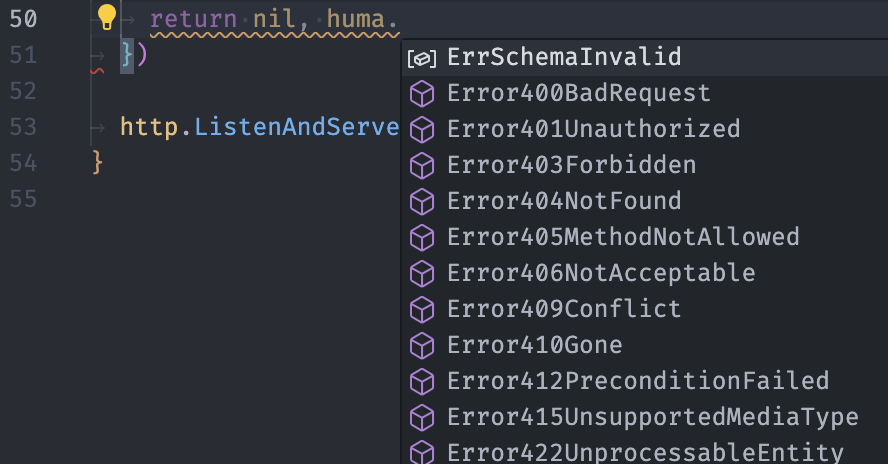Response Errors#
Returning HTTP Errors#
Handler functions can return errors instead of a successful response. There are a number of utility functions to return common HTTP errors:
huma.Register(api, huma.Operation{
OperationID: "get-thing",
Method: http.MethodGet,
Path: "/things/{thing-id}",
Summary: "Get a thing by ID",
}, func(ctx context.Context, input ThingRequest) (*struct{}, error) {
// Return a 404 Not Found error
return nil, huma.Error404NotFound("thing not found")
}
The error functions are named like Error{code}{name} and accept a message and error details which can provide more information back to the user. For example, huma.Error400BadRequest(msg string, errs ...error). Editors like VSCode should automatically show the available errors as you type:

Default Error Response
If the error returned has no associated HTTP status code, for example you use fmt.Errorf("my error"), then the default error response code is 500 Internal Server Error. Use huma.NewError to return an error with a custom status code.
Error Model#
Errors use RFC 9457 Problem Details for HTTP APIs with a content type like application/problem+json and return a structure that looks like:
HTTP/2.0 422 Unprocessable Entity
Cache-Control: private
Content-Length: 241
Content-Type: application/problem+json
Link: </schemas/ErrorModel.json>; rel="describedBy"
{
"$schema": "https://api.rest.sh/schemas/ErrorModel.json",
"status": 422,
"title": "Unprocessable Entity",
"detail": "validation failed",
"errors": [
{
"location": "body.title",
"message": "expected string",
"value": true
},
{
"location": "body.reviews",
"message": "unexpected property",
"value": {
"reviews": 5,
"title": true
}
}
]
}
The errors field is optional and may contain more details about which specific errors occurred. See huma.ErrorModel for more details.
To display a location, message, and value in the errors array, use the huma.ErrorDetail struct. If you need to wrap this with custom logic for any reason, you can implement the huma.ErrorDetailer interface.
Exhaustive Errors#
It is recommended to return exhaustive errors whenever possible to prevent user frustration with having to keep retrying a bad request and getting back a different error.
Input parameters validation, body validation, resolvers, etc all support returning exhaustive errors. Because of this, it's preferable to use them over custom error logic in your operation handler.
Error Status Codes#
While every attempt is made to return exhaustive errors within Huma, each individual response can only contain a single HTTP status code. The following chart describes which codes get returned and when:
flowchart TD
Request[Request has errors?] -->|yes| Panic
Request -->|no| Continue[Continue to handler]
Panic[Panic?] -->|yes| 500
Panic -->|no| RequestBody[Request body too large?]
RequestBody -->|yes| 413
RequestBody -->|no| RequestTimeout[Request took too long to read?]
RequestTimeout -->|yes| 408
RequestTimeout -->|no| ParseFailure[Cannot parse input?]
ParseFailure -->|yes| 400
ParseFailure -->|no| ValidationFailure[Validation failed?]
ValidationFailure -->|yes| 422
ValidationFailure -->|no| 400This means it is possible to, for example, get an HTTP 408 Request Timeout response that also contains an error detail with a validation error for one of the input headers. Since request timeout has higher priority, that will be the response status code that is returned.
Error Headers#
Middleware can be used to add headers to all responses, e.g. for cache control, rate limiting, etc. For headers specific to errors or specific handler error responses, you can wrap the error with additional headers as needed:
return nil, huma.ErrorWithHeaders(
huma.Error404NotFound("thing not found"),
http.Header{
"Cache-Control": {"no-store"},
},
)
It is safe to call huma.ErrorWithHeaders multiple times, and all the passed headers will be appended to any existing ones.
Any error which satisfies the huma.HeadersError interface will have the headers added to the response.
Custom Errors#
It is possible to provide your own error model and have the built-in error utility functions use that model instead of the default one. This is useful if you want to provide more information in your error responses or your organization has requirements around the error response structure.
This is accomplished by defining your custom model as a huma.StatusError and then overriding the built-in huma.NewError function:
type MyError struct {
status int
Message string `json:"message"`
Details []string `json:"details,omitempty"`
}
func (e *MyError) Error() string {
return e.Message
}
func (e *MyError) GetStatus() int {
return e.status
}
func main() {
huma.NewError = func(status int, message string, errs ...error) huma.StatusError {
details := make([]string, len(errs))
for i, err := range errs {
details[i] = err.Error()
}
return &MyError{
status: status,
Message: message,
Details: details,
}
}
router := chi.NewMux()
api := humachi.New(router, huma.DefaultConfig("My API", "1.0.0"))
huma.Register(api, huma.Operation{
OperationID: "get-error",
Method: http.MethodGet,
Path: "/error",
}, func(ctx context.Context, i *struct{}) (*struct{}, error) {
return nil, huma.Error404NotFound("not found", fmt.Errorf("some-other-error"))
})
http.ListenAndServe(":8888", router)
}
To change the default content type that is returned, you can also implement the huma.ContentTypeFilter interface.
Dive Deeper#
- Reference
huma.ErrorModelthe default error modelhuma.ErrorDetaildescribes location & value of an errorhuma.StatusErrorinterface for custom errorshuma.HeadersErrorinterface for errors with headershuma.ContentTypeFilterinterface for custom content types
- External Links
- HTTP Status Codes
- RFC 9457 Problem Details for HTTP APIs